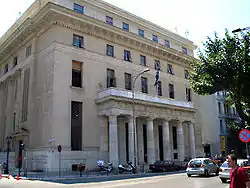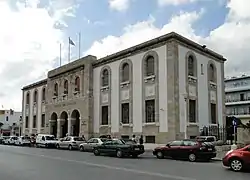 | |
 Head office of the Bank of Greece in Athens | |
| Headquarters | Athens, Greece |
|---|---|
| Coordinates | 37°58′43″N 23°44′00″E / 37.978611°N 23.733333°E |
| Established | 14 May 1928 |
| Ownership | e-E.F.K.A. Electronic National Social Security Entity (12.44%) Hellenic Public Sector (8.93%)[1] |
| Governor | Yannis Stournaras |
| Central bank of | Greece |
| Reserves | 1 500 million USD[2] |
| Succeeded by | European Central Bank (2001)1 |
| Website | www |
| 1 The Bank of Greece still exists but many functions have been taken over by the ECB. | |
| Economy of Greece |
|---|
 |
| Overview |
| History |
| Related |
The Bank of Greece (Greek: Τράπεζα της Ελλάδος Trapeza tis Ellados, abbr. ΤτΕ) is the Greek member of the Eurosystem and has been the monetary authority for Greece from 1927 to 2000, issuing the drachma. Since 2014, it has also been Greece's national competent authority within European Banking Supervision.[3] Its headquarters is located in Athens on Panepistimiou Street, and it also has several branches across the country. Unlike most contemporary central banks, the Bank of Greece still has private shareholders and its stock is listed on the Athens Exchange.[4]
History
The Bank of Greece was established by Law 3424/7 December 1927, under the conditions of the stabilization loan coordinated by the Economic and Financial Organization of the League of Nations,[5] and its operations started officially in 1928. The shares of the Bank of Greece are registered and have been listed on the Athens Exchange since June 12, 1930.[6]
The building that currently houses its headquarters was completed ten years later in 1938.[7]
Until January 2001 (when Greece adopted the euro) the bank was responsible for the former national currency, the drachma. Greece had failed to meet the membership criteria and was excluded from participating when the euro was launched on 1 January 1999. Use of physical drachma notes and coins continued until 31 December 2001, as denominations of the euro.
Ownership and operations
The Bank of Greece is a partially state owned S.A. share company with special privileges, special restrictions, and duties.[8] It cannot operate as a commercial bank and the percentage of shares that can be under Greek state ownership cannot exceed 35%[9] (initially this limit was 10%[10]). It has a staff of more than 1,800 employees.
The primary objective of the Bank of Greece is to ensure price stability in Greece. It also supervises the private banks and acts as a treasurer and fiscal agent for the Greek government. Since law 3867/2010 was passed the Bank of Greece is also responsible for supervising private insurance companies, merging with the Committee for the Supervision of Insurance Companies established by law 3229/2004.
Its Euro banknotes printer identification code is Y.[11]
The Bank of Greece also sells gold sovereigns.
Leadership
Governors
The chief officer of the Bank of Greece is the Governor (Greek: διοικητής, IPA: [ðiiciˈtis]), a governmental appointee.[12]
| Officeholder | Entered office | Left office | Notes |
|---|---|---|---|
| Alexandros Diomidis | April 21, 1928 | September 29, 1931 | Prime Minister 1949–50 |
| Emmanouil Tsouderos | October 31, 1931 | August 13, 1935 | First term |
| Emmanouil Tsouderos | March 20, 1936 | July 10, 1939 | Second term; Prime Minister 1941–44 (in exile) |
| Ioannis Drosopoulos | July 10, 1939 | July 28, 1939 | |
| Kyriakos Varvaresosa | August 4, 1939 | February 2, 1946 | |
| Xenophon Zolotas | October 12, 1944 | January 8, 1945 | First term; co-Governor |
| Georgios Mantzavinos | February 11, 1946 | February 2, 1955 | |
| Xenophon Zolotas | February 5, 1955 | August 7, 1967 | Second term |
| Dimitrios Galanis | August 7, 1967 | May 4, 1973 | |
| Konstantinos Papagiannis | May 7, 1973 | August 9, 1974 | |
| Panagis Papaligouras | August 9, 1974 | October 24, 1974 | |
| Xenophon Zolotas | November 26, 1974 | November 3, 1981 | Third term; Prime Minister 1989–90 |
| Gerasimos Arsenis | November 3, 1981 | February 20, 1984 | |
| Dimitrios Chalikias | February 20, 1984 | February 20, 1992 | |
| Efthymios Christodoulou | February 20, 1992 | December 1, 1993 | |
| Ioannis Boutos | December 1, 1993 | October 26, 1994 | |
| Lucas Papademos | October 26, 1994 | June 14, 2002 | Prime Minister 2011–12 |
| Nikolaos Garganas | June 14, 2002 | June 14, 2008 | Greek Financial Audit, 2004 |
| Georgios Provopoulos | June 20, 2008 | June 20, 2014 | Greek government-debt crisis; European debt crisis |
| Yannis Stournaras | 20 June 2014 | Incumbent | Greek government-debt crisis; European debt crisis |
a During the Axis occupation of Greece (1941–44), Governor Kyriakos Varvaresos followed the Greek government in exile to London. The collaborationist governments in Greece fired Varvaresos in 1941 and appointed first Miltiadis Negrepontis as Governing Counsellor (April 24, 1941 – July 3, 1941) and then Dimitrios Santis (July 3, 1941 – January 20, 1943) and finally Theodoros Tourkovasilis (April 19, 1943 – April 13, 1944) as Governors. After the liberation all dismissals and appointments by occupation-era governments concerning members of the administration of the Bank of Greece were declared null and void.
Deputy governors
The Deputy Governor (Greek: υποδιοικητής, romanized: ypodioikētés) is the Bank's second-in-line officer. Traditionally the Deputy Governors' main remit is administration, whereas Governors supervise monetary policy at large.[13]


- Emmanouil Tsouderos: April 21, 1928 – October 31, 1931
- Emmanouil Kamaras: November 25, 1931 – May 30, 1932
- Kyriakos Varvaresos: March 1, 1933 – August 4, 1939
- Georgios Mantzavinos (*): September 28, 1936 – February 11, 1946
- Ioannis Arvanitis: August 4, 1939 – April 26, 1941
- Stylianos Gregoriou: March 28, 1945 – February 2, 1955
- Vasileios Kyriakopoulos: February 5, 1955 – December 24, 1955
- Dimitrios Galanis: December 31, 1955 – August 7, 1967
- Ioannis Pesmazoglou: February 11, 1960 – August 5, 1967
- Konstantinos Thanos: January 5, 1968 – September 10, 1969
- Efstathios Panas: September 11, 1969 – August 9, 1974
- Nikolaos Kyriazidis: August 9, 1974 – January 5, 1977
- Nikolaos Charisopoulos: October 21, 1975 – November 6, 1981
- Evangelos Devletoglou: December 23, 1977 – November 8, 1978
- Georgios Drakos: November 24, 1978 – October 20, 1981
- Dimitrios Chalikias: November 16, 1981 – February 6, 1984
- Evangelos Kourakos (1st period): July 10, 1982 – February 11, 1986
- Panagiotis Korliras: February 20, 1984 – August 30, 1985
- Efstathios Papageorgiou: September 17, 1985 – September 17, 1989
- George Provopoulos: October 1, 1990 – November 29, 1993
- Vasileios Antonioudakis: October 1, 1990 – December 19, 1991
- Panagiotis Pavlopoulos: February 21, 1992 – November 29, 1993
- Evangelos Kourakos (2nd period): December 1, 1993 – September 4, 1996
- Lucas Papademos: December 1, 1993 – October 26, 1994
- Panagiotis Thomopoulos: October 26, 1994 – February 26, 2009
- Nikolaos Garganas: September 5, 1996 – June 13, 2002
- Nikolaos Palaiokrassas: June 14, 2002 – June 14, 2008
- Eleni Dendrinou Louri: June 20, 2008 – June 20, 2014
- Iannis Mourmouras: September, 2014 -
- Theodoros Mitrakos: March 2015 -
(*): During the Axis occupation of Greece (1941–44), Deputy Governor Georgios Mantzavinos followed the Greek government in exile to London. The collaborationist governments in Greece fired Mantzavinos in 1941 and appointed Andreas Papadimitriou (July 3, 1941 – November 18, 1941) and Spyridon Hatzikyriakos (April 5, 1943 – October 5, 1944) as Deputy Governors. After the liberation all dismissals and appointments by occupation-era governments concerning members of the administration of the Bank of Greece were declared null and void.
See also
References
- ↑ "Profile - athexgroup.gr".
- ↑ Weidner, Jan (2017). "The Organisation and Structure of Central Banks" (PDF). Katalog der Deutschen Nationalbibliothek.
- ↑ "National supervisors". ECB Banking Supervision.
- ↑ Athex: TELL
- ↑ Kakridis, Andreas (2023), Kakridis, Andreas; Eichengreen, Barry (eds.), "'Nobody's Child': The Bank of Greece in the Interwar Years", The Spread of the Modern Central Bank and Global Cooperation: 1919–1939, Cambridge University Press, pp. 225–267, doi:10.1017/9781009367578.012, ISBN 978-1-009-36757-8
- ↑ Michalis Psalidopoulos (October 2019), History of the Bank of Greece 1928-2008: From government's banker to guardian of financial stability (PDF), Athens: Bank of Greece
- ↑ "Bank of Greece (en) - Contemporary Monuments Database". National Hellenic Research Foundation. Retrieved 27 September 2014.
- ↑ Bank of Greece articles of association Archived 2013-10-15 at the Wayback Machine, Edition Θ, 2000 Chapter Χ, «ΕΡΓΑΣΙΑΙ ΤΗΣ ΤΡΑΠΕΖΗΣ ΚΑΙ ΜΕΣΑ ΝΟΜΙΣΜΑΤΙΚΗΣ ΠΟΛΙΤΙΚΗΣ» (Retrieved 31/03/2011)
- ↑ Bank of Greece articles of association Archived 2013-10-15 at the Wayback Machine, Edition Θ, 2000, Chapter ΙΙ, Article 8, «ΚΕΦΑΛΑΙΟ ΚΑΙ ΑΠΟΘΕΜΑΤΙΚΑ» (Retrieved 31/03/2011)
- ↑ Bank of Greece articles of association, Edition Α, 1928, Part ΙΙ, Article 8, «ΚΕΦΑΛΑΙΟ ΚΑΙ ΑΠΟΘΕΜΑΤΙΚΑ» (retrieved 11/11/2016).
- ↑ "Euro FAQ". The Euro Information Website. Retrieved 15 January 2009.
- ↑ "Governors of the Bank of Greece" (PDF). Archived from the original (PDF) on 2014-08-09. Retrieved 2014-06-24.
- ↑ Deputy Governors of the Bank of Greece
External links
- (in Greek and English) Bank of Greece official site
- Governor report on the balance sheet of 31st December 1928